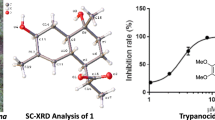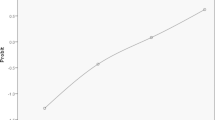Abstract
The menace caused by ticks and tick-borne diseases is a major limitation to the livestock industry in Africa. The high costs and non-availability of synthetic, chemical acaricides to resource-limited farmers, resistance of ticks to available acaricides and residue problems in meat and milk consumed by humans further complicate matters. The use of plant extracts as a possible source of new acaricides has received much interest in the last decade. In our endeavour to discover natural acaricidal compounds, tick toxicant bioassays were conducted and the chloroform fraction of Calpurnia aurea ethanol leaf extract had good acaricidal activity. Further purification of the fraction revealed two flavonoids, isolated from C. aurea for the first time. These flavonoids were characterized as apigenin-7-O-β-d-glycoside and isorhoifolin by means of NMR spectroscopic and mass spectrometry analysis. Isorhoifolin was the most potent compound (LC50 = 0.65 mg/ml), was not cytotoxic and should be further investigated for its potential as an acaricidal agent.

Similar content being viewed by others
References
Abd-Alla HI, Moharram FA, Gaara AH, El-Safty MM (2009) Phytoconstituents of Jatropha curcas L. leaves and their immunomodulatory activity on humoral and cell-mediated immune response in chicks. Z Naturforsch C 64(7–8):495–501. https://doi.org/10.1515/znc-2009-7-805
Al-Rajhy DH, Alahmed AM, Hussein HI, Kheir SM (2003) Acaricidal effects of cardiac glycosides, azadirachtin and neem oil against the camel tick, Hyalomma dromedarii (Acari: Ixodidae). Pest Manag Sci 59(11):1250–1254
Boghrati Z, Naseri M, Rezaie M, Pham N, Quinn RJ, Tayarani-Najaran Z, Iranshahi M (2016) Tyrosinase inhibitory properties of phenylpropanoid glycosides and flavonoids from Teucrium polium L. var. gnaphalodes. Iran J Basic Med Sci 19(8):804
Chapman Hall (2017) Dictionary of natural products on CD-ROM. Chemical DataBase
Chen Z, Ying X, Meng S, Zhu X, Jiang H, Cao Q, Li X, Meng F (2011) High-performance liquid chromatographic determination and pharmacokinetic study of apigenin-7-O-β-d-glucoside in rat plasma after intravenous administration. Arch Pharm Res 34(5):741–746
Dantas A, Machado D, Araujo A, Oliveira-Junior R, Lima-Saraiva S, Ribeiro L, Almeida J, Horta M (2015) Acaricidal activity of extracts from the leaves and aerial parts of Neoglaziovia variegata (Bromeliaceae) on the cattle tick Rhipicephalus (Boophilus) microplus. Res Vet Sci 100:165–168. https://doi.org/10.1016/j.rvsc.2015.04.012
Eloff J (1998) Which extractant should be used for the screening and isolation of antimicrobial components from plants? J Ethnopharm 60(1):1–8. https://doi.org/10.1016/s0378-8741(97)00123-2
Fouche G, Ramafuthula M, Maselela V, Mokoena M, Senabe J, Leboho T, Sakong BM, Adenubi OT, Eloff JN, Wellington KW (2016) Acaricidal activity of the organic extracts of thirteen South African plants against Rhipicephalus (Boophilus) decoloratus (Acari: Ixodidae). Vet Parasitol 224:39–43. https://doi.org/10.1016/j.vet.par.2016.05.011
Getiye Y, Tolessa T, Engidawork E (2016) Antihypertensive activity of 80% methanol seed extract of Calpurnia aurea (Ait.) Benth. subsp. aurea (Fabaceae) is mediated through calcium antagonism induced vasodilation. J Ethnopharm 189:99–106. https://doi.org/10.1016/j.jep.2016.04.056
Ghosh S, Tiwari SS, Kumar B, Srivastava S, Sharma AK, Kumar S, Bandyopadhyay A, Julliet S, Kumar R, Rawat AKS (2015) Identification of potential plant extracts for anti-tick activity against acaricide resistant cattle ticks, Rhipicephalus (Boophilus) microplus (Acari: Ixodidae). Exp Appl Acarol 66(1):159–171. https://doi.org/10.1007/s10493-015-9890-7
Gulluce M, Orhan F, Yanmis D, Arasoglu T, Guvenalp Z, Demirezer LO (2015) Isolation of a flavonoid, apigenin 7-O-glucoside, from Mentha longifolia (L.) Hudson subspecies longifolia and its genotoxic potency. Toxicol Ind Health 31(9):831–840. https://doi.org/10.1177/0748233713475511
Habeeb SM (2010) Ethno-veterinary and medical knowledge of crude plant extracts and its methods of application (traditional and modern) for tick control. World Appl Sci J 11(9):1047–1054
Hawryl MA, Niemiec MA, Slomka K, Waksmundzka-Hajnos M, Szymczak G (2016) Two-dimensional micro-TLC phenolic fingerprints of selected Mentha sp. on cyano-bonded polar stationary phase. J Chromatogr Sci 54(1):64–69. https://doi.org/10.1093/chromsci/bmv093
Juliet S, Ravindran R, Ramankutty SA, Gopalan AKK, Nair SN, Kavillimakkil AK, Bandyopadhyay A, Rawat AKS, Ghosh S (2012) Jatropha curcas (Linn) leaf extract—a possible alternative for population control of Rhipicephalus (Boophilus) annulatus. Asian Pac J Trop Dis 2(3):225–229. https://doi.org/10.1016/S2222-1808(12)60051-6
Klyne W (1950) The configuration of the anomeric carbon atoms in some cardiac glycosides. Biochem J 47(4):xli–xlii
Kokotkiewicz A, Luczkiewicz M, Sowinski P, Glod D, Gorynski K, Bucinski A (2012) Isolation and structure elucidation of phenolic compounds from Cyclopia subternata Vogel (honeybush) intact plant and in vitro cultures. Food Chem 133:1373–1382. https://doi.org/10.1016/j.foodchem.2012.01.114
Madzimure J, Nyahangare ET, Hamudikuwanda H, Hove T, Stevenson PC, Belmain SR, Mvumi BM (2011) Acaricidal efficacy against cattle ticks and acute oral toxicity of Lippia javanica (Burm F.) Spreng. Trop Anim Health Prod 43(2):481–489. https://doi.org/10.1007/s11250-010-9720-1
McGaw LJ, Eloff JN (2010) Methods for evaluating efficacy of ethnoveterinary medicinal plants. In: Ethnoveterinary botanical medicine: herbal medicines for animal health, pp 1–24
Mondal D, Sarma K, Saravanan M (2013) Upcoming of the integrated tick control program of ruminants with special emphasis on livestock farming system in India. Ticks Tick Borne Dis 4:1–10. https://doi.org/10.1016/j.ttbdis.2012.05.006
Mosmann T (1983) Rapid colorimetric assay for cellular growth and survival: application to proliferation and cytotoxicity assays. J Immunol Methods 65(1–2):55–63. https://doi.org/10.1016/0022-1759(83)90303-4
Mukandiwa L, Ahmed A, Naidoo V, Eloff JN (2013) Isolation of seselin isolated from Clausena anisata (Rutaceae) leaves and its effects on the feeding and development of Lucilia cuprina larvae may explain its the use in ethnoveterinary medicine to treat myiasis. J Ethnopharm 150:886–891. https://doi.org/10.1016/j.jep.2013.09.037
Nana P, Maniania N, Maranga R, Kutima H, Boga H, Nchu F, Eloff J (2010) Attraction response of adult Rhipicephalus appendiculatus and Rhipicephalus pulchellus (Acari: Ixodidae) ticks to extracts from Calpurnia aurea (Fabaceae). Vet Parasitol 174(1):124–130. https://doi.org/10.1016/j.vetpar.2010.08.016
Nana P, Nchu F, Ekesi S, Boga HI, Kamtchouing P, Maniania NK (2015) Efficacy of spot-spray application of Metarhizium anisopliae formulated in emulsifiable extract of Calpurnia aurea in attracting and infecting adult Rhipicephalus appendiculatus ticks in semi-field experiments. J Pest Sci 88(3):613–619. https://doi.org/10.1007/s10340-014-0637-8
Nassar MI, Mohamed TK, Elshamy AI, El-Toumy SA, Lateef AMA, Farrag AH (2013) Chemical constituents and anti-ulcerogenic potential of the scales of Cynara scolymus (artichoke) heads. J Sci Food Agric 93(10):2494–2501. https://doi.org/10.1002/jsfa.6065
Nondo RSO, Moshi MJ, Erasto P, Zofou D, Njouendou AJ, Wanji S, Ngemenya MN, Kidukuli AW, Masimba PJ, Titanji VPK (2015) Evaluation of the cytotoxic activity of extracts from medicinal plants used for the treatment of malaria in Kagera and Lindi regions, Tanzania. J App Pharm Sci 5(4):7–12
Obenchain FD, Galun R (2013) Physiology of ticks: current themes in tropical science. Elsevier, Amsterdam, pp 1–501
Peng HY, Zhang XH, Xu JZ (2016) Apigenin-7-O-β-d-glycoside isolation from the highly copper-tolerant plant Elsholtzia splendens. J Zhejiang Univ Sci B 17(6):447–454. https://doi.org/10.1631/jzus.B1500242
Ravindran R, Juliet S, Sunil A, Kumar KA, Nair SN, Amithamol K, Shynu M, Rawat AKS, Ghosh S (2011) Eclosion blocking effect of ethanolic extract of Leucas aspera (Lamiaceae) on Rhipicephalus (Boophilus) annulatus. Vet Parasitol 179(1):287–290. https://doi.org/10.1016/j.vetpar.2011.02.021
Sonenshine DE, Roe RM (2013) Overview: ticks, people and animals. In: Sonenshine DE, Roe RM (eds) The biology of ticks, vol 1. Oxford University Press, New York
Wellington KW, Leboho T, Sakong BM, Adenubi OT, Eloff JN, Fouche G (2017) Further studies on South African plants: Acaricidal activity of organic plant extracts against Rhipicephalus (Boophilus) microplus (Acari: Ixodidae). Vet Parasitol 234:10–12. https://doi.org/10.1016/j.vetpar.2016.12.014
Wölwer-Rieck U (2012) The leaves of Stevia rebaudiana (Bertoni), their constituents and the analyses thereof: a review. J Agric Food Chem 60(4):886–895. https://doi.org/10.1021/jf.2044907
Zorloni A, Penzhorn BL, Eloff JN (2010) Extracts of Calpurnia aurea leaves from southern Ethiopia attract and immobilise or kill ticks. Vet Parasitol 168:160–164. https://doi.org/10.1016/j.vetpar.2009.10.026
Acknowledgements
Financial support from the Technology Innovation Agency in conjunction with the Council for Scientific and Industrial Research, University of Pretoria and the Schlumberger Faculty for the Future Foundation is thankfully acknowledged.
Author information
Authors and Affiliations
Corresponding author
Rights and permissions
About this article
Cite this article
Adenubi, O.T., Ali Abdalla, M., Ahmed, A.S. et al. Isolation and characterization of two acaricidal compounds from Calpurnia aurea subsp. aurea (Fabaceae) leaf extract. Exp Appl Acarol 75, 345–354 (2018). https://doi.org/10.1007/s10493-018-0269-4
Received:
Accepted:
Published:
Issue Date:
DOI: https://doi.org/10.1007/s10493-018-0269-4




